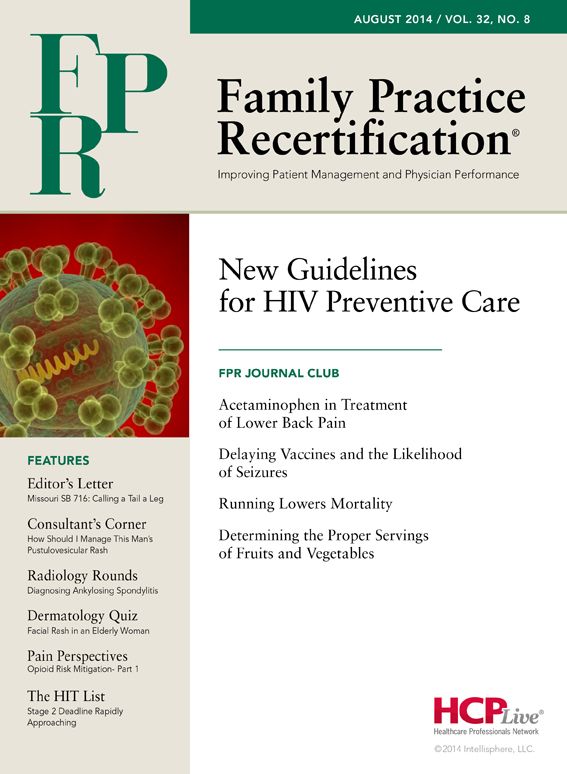Acetaminophen in Treatment of Lower Back Pain
Many guidelines recommend the use of acetaminophen (called paracetamol in Europe) and/or NSAIDs for the treatment of acute low back pain. The reason for this is acetaminophen and NSAIDs are relatively safe and effective with regard to managing musculoskeletal pain. This study determined the efficacy of acetaminophen alone vs. placebo for acute low back pain.

Frank J. Domino, MD
Review
“Is Acetaminophen (Paracetamol) Effective for Acute Low Back Pain,” Lancet, published online
July 24, 2014.
Many guidelines recommend the use of acetaminophen (called paracetamol in Europe) and/or NSAIDs for the treatment of acute low back pain. The reason for this is acetaminophen and NSAIDs are relatively safe and effective with regard to managing musculoskeletal pain. This study determined the efficacy of acetaminophen alone vs. placebo for acute low back pain.
Study Methods
This randomized controlled trial compared acetaminophen given 3 times a day for a total of 4,000 mg a day vs. PRN doses of acetaminophen to a maximum of 4,000 mg per day vs. a placebo. All patients also received patient information and best evidence advice and were followed up for 3 months. The primary outcome was recovery from acute low back pain (defined as a score of 0-1 on a 0-10 pain scale) for seven consecutive days.
Results and Outcomes
Approximately 1,600 patients were included in this study and randomly assigned equally to each group. Median time to recovery was 17 days in the regularly dosed group vs. 17 days in the PRN group vs. 16 days in the placebo group. There was no statistical difference between dates of recovery.
Conclusion
A standing dose of acetaminophen is no more effective than a PRN dose or a placebo in acute treatment of low back pain at 3 months.
Commentary
This randomized controlled trial tells us many things that are helpful to understand and appreciate about the management of acute low back pain. Most importantly it shows us that by 17 days most patients get better without any pharmacologic intervention on our part. Nonetheless, management of pain during those first 17 days can be a challenge.
This study does not tell us about patient satisfaction about doing something (ie, taking a standing dose of medication) was over PRN dosing or placebo. Patients need to feel empowered in their recovery and offering stretching, manual medicine like osteopathic care, and taking a pill reinforces patient autonomy. That is, the sense their actions contribute to their recovery, and health. This title can lead physicians to believe that nothing should be done to treat pain for patients with acute low back pain.
Drilling down further on this data demonstrates that those who took acetaminophen on a regular basis used far fewer adjuvant medications, especially those involving opioids (though the difference was not found to be statistically significant in the Lancet trial.) This is a critical point in that providers must understand the danger of using opioids for this self limiting condition. Opioids must be avoided because they increase the risk of acute low back pain evolving into chronic low back pain and disability (J. Ashworth et al. / PAIN_ 154 (2013) 1038—1044). Even short-term use can result in a lifetime of lost employment and functionality.
The best evidence on treating acute back suggests the following:
--Combining acetaminophen with an NSAID[QMA1] . This trial found the combination helpful. Adding acetaminophen to tramadol was studied in a randomized controlled trial of acetaminophen (paracetamol)/tramadol (325 mg/37.5 mg) in combination compared to tramadol at 50 mg as monotherapy for those with sub-acute low back pain. The combination group had equal efficacy regarding pain control with significantly fewer side effects as compared to the tramadol alone group (Clinical Therapeutics 2006; 28:1592-1606).
--Non-benzodiazepine muscle relaxants have been found to help reduce pain and disability at days 2-5 but do induce an increased risk of adverse effects, like sedation (Cochrane Database Syst Rev 2003;(2):CD004252)
--Use of heat (if it makes the patient feel better): a randomized efficacy trial compared using continuous low level heat wrap (40°C, 8 hours a day) with ibuprofen 1,200 mg a day plus acetaminophen 4,000 mg a day in subjects with acute non-specific low back pain. Patients obtained relief on days 1, 3, and 4, favored the heat wrap as did lateral trunk flexibility and muscle stiffness without adverse effects. (Spine 2002; 27:1012-1017, Cochrane Database Syst Rev. 2006 Jan 25;(1):CD004750)
--Osteopathic manipulation was found to improve function faster in the first 6 months following onset of acute low back pain, especially in those that initially fail medication (Fam Pract 2003 Dec;20(6):662)
--Stay active; limit bed rest to less than 2 days following the injury, walk, and return to work as soon as possible. ( Cochrane Database Syst Rev 2010 Jun 16;(6):CD007612)
While this study found no improvement in recovery time, pain intensity, disability, function, global symptoms scores, sleep, or quality of life over the 3 months of follow-up, it should not alter your practice of using acetaminophen for acute low back pain.
Rather, this study should encourage researchers to evaluate the use of a combination of paracetamol and NSAIDs compared to either alone or placebo for management of acute low back pain. Until then, patients should be aggressively managed with safe medication, manipulation, activity, and keeping in mind the desire to do no harm by not using narcotics.
[QMA1]Neither the Lancet article nor the Clinical Therapeutics article provided data to support this recommendation
About the Author
Frank J. Domino, MD, is Professor and Pre-Doctoral Education Director for the Department of Family Medicine and Community Health at the University of Massachusetts Medical School in Worcester, MA. Domino is Editor-in-Chief of the 5-Minute Clinical Consult series (Lippincott Williams & Wilkins).
Additionally, he is Co-Author and Editor of the Epocrates LAB database, and author and editor to the MedPearls smartphone app. He presents nationally for the American Academy of Family Medicine and serves as the Family Physician Representative to the Harvard Medical School’s Continuing Education Committee.
